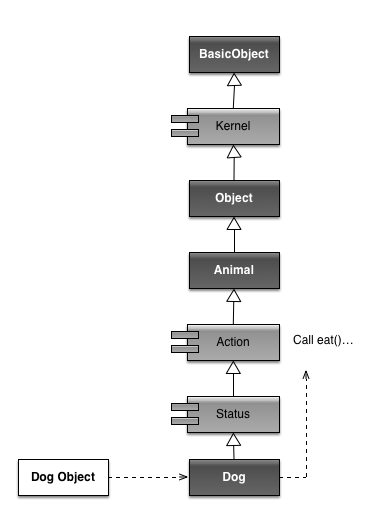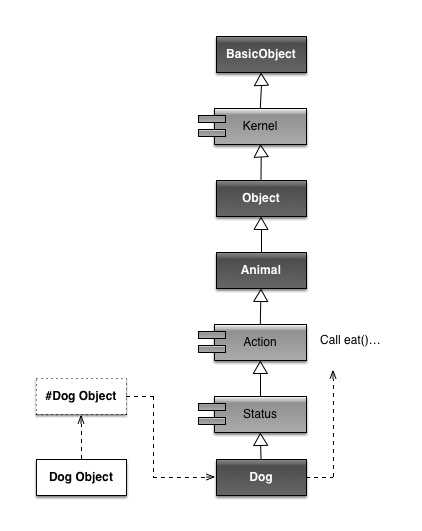Ruby Ruby 的方法查找与 method_missing
第一次发帖子,多少有些紧张 ...
在 Ruby 中方法调用都是通过对象。方法的形式。当调用一个方法时,Ruby 会在对象的类中查找那个方法,如果当前类中没有这个方法的定义,Ruby 会搜索祖先链,看看其中是否存在这个方法。再更进一步前,我们得先来了解下什么是“祖先链”。
在 Ruby 的世界里,“祖先链”是一个很重要的概念。祖先链为我们展示了一个完整的类继承路径,同时它也是 Ruby 中方法查找的路径。 先来看一个简单的情况:
class Animal; end
class Dog < Animal
end
def my_ancestors(klass)
a = []
a << klass
sc = klass.superclass
until sc==nil
a << sc
sc = sc.superclass
end
a
end
p my_ancestors Dog
首先,我们定义两个类Animal、Dog。其中Dog继承Animal类。superclass()方法可以访问到某个类的父类。my_ancestors()方法,会帮助我们输出一个类的所有父类。我们想象中Dog的祖先链应该是这样:

但是执行这段代码会输出如下的内容:
[Dog, Animal, Object, BasicObject]
其中多了 Object,BasicObject两个类。可见一个 Ruby 类如果不声明父类,默认继承于Object类。而Object又继承于BasicObject类(Ruby 1.9 版本引入了 BasicObject)。BasicObject是这条继承链的顶端。于是现在的继承链应该是:

这就是一个类的祖先链了吗?别忘了还有模块没有试验。下面我们来添加一个Action模块,这个模块可以为类添加一些方法:
module Action
def eat
puts 'eat'
end
end
class Animal; end
class Dog < Animal
include Action
end
def my_ancestors(klass)
a = []
a << klass
sc = klass.superclass
until sc == nil
a << sc
sc = sc.superclass
end
a
end
p my_ancestors Dog
再运行这个脚本,发现输出跟刚才没有什么区别:
[Dog, Animal, Object, BasicObject]
在这个输出中,我们并没有发现添加进来的模块。看来使用superclass()方法并不能访问到添加到类中模块。那么模块被添加到哪里了呢?还好,Ruby 提供了一个更强力的方法ancestors(),可以打印一个类所有的祖先。在脚本文件中加上一行
p Dog.ancestors
然后执行脚本:
[Dog, Animal, Object, BasicObject]
[Dog, Action, Animal, Object, Kernel, BasicObject]
在新的输出中,我们找到了Action模块,它位于Dog类的上方。同时我们还发现了另一个东西 -- kernel,它是 Ruby 在Object类中引入的一个模块。这使得我们可以在任何对象上调用 kernel 中定义的方法。
如果一个类中添加了多个模块呢?再添加一个模块,看看输出:
module Action
def eat
puts 'eat'
end
end
module Status
def sleeping?
true
end
end
class Animal; end
class Dog < Animal
include Action
include Status
end
def my_ancestors(klass)
a = []
a << klass
sc = klass.superclass
until sc == nil
a << sc
sc = sc.superclass
end
a
end
p my_ancestors Dog
p Dog.ancestors
[Dog, Animal, Object, BasicObject]
[Dog, Status, Action, Animal, Object, Kernel, BasicObject]
可见新的模块被添加到Dog上方,最接近Dog的地方。现在祖先链完整了。它包括了从当前类到BasicObject类的完整路径。

好了,明白了什么是祖先链,现在让我们回到主题,看看当在一个对象上调用方法时,Ruby 如何查找这个方法。
1. 先看一个简单的情况,在一个包含模块且有继承关系的类如何查找方法。
module Action
def eat
puts 'eat in module Action'
end
end
module Status
def sleeping?
true
end
end
class Animal; end
class Dog < Animal
include Action
include Status
end
def my_ancestors(klass)
a = []
a << klass
sc = klass.superclass
until sc == nil
a << sc
sc = sc.superclass
end
a
end
#p my_ancestors Dog
Dog.new.eat
p Dog.ancestors
Dog类本身没有eat()方法,我们在Dog的对象上调用eat()方法后,Ruby 会先查找Dog类中的实例方法,然后沿着祖先链一直向上找,直到找到Action模块中的方法后进行了调用。

这种查找能到什么程度呢?如祖先链表示的,接下来就是 Object 类,这是 Ruby 中一切对象的开始。其中有一个模块Kernel。也就是说,如果你在 Kernel 中定义了一个方法,那么 Ruby 中的所有对象都可以用这个方法。
2. 如果类和混入的模块中有相同的方法,会发生什么呢?
class Dog < Animal
include Action
include Status
def eat
puts 'eat from dog'
end
end
我们在Dog类中添加了新的eat()方法。运行后输出:
eat from dog
[Dog, Status, Action, Animal, Object, Kernel, BasicObject]
可以看出来,Ruby 调用了Dog类中的eat()方法。也就是说,如果存在同名方法,在祖先链中靠前的方法会覆盖靠后的方法。这个规则同样适用于混入的多个模块中存在同名方法的情况。
这是不是 Ruby 方法查找路径的全部呢?我们来看个简单的例子:
class Foo; end
a = Foo.new
b = Foo.new
class << b
def bar
puts 'bar'
end
end
b.bar
a.bar
在 irb 里运行:
2.1.2 :001 > class Foo;end
=> nil
2.1.2 :002 > a = Foo.new
=> #<Foo:0x007fc019952e38>
2.1.2 :003 > b = Foo.new
=> #<Foo:0x007fc01994ae90>
2.1.2 :004 > class << b
2.1.2 :005?> def bar; puts 'bar'; end
2.1.2 :006?> end
=> :bar
2.1.2 :007 > b.bar
bar
=> nil
2.1.2 :008 > a.bar
NoMethodError: undefined method `bar' for #<Foo:0x007fc019952e38>
from (irb):8
from /Users/molezz/.rvm/rubies/ruby-2.1.2/bin/irb:11:in `<main>'
很奇怪,a和b都是Foo类的对象,为什么bar()方法在b对象中存在,而a中却没有呢?看来 Ruby 还有隐藏关卡。
class << b
def bar
puts 'bar'
end
end
这个写法,打开了b对象的单件类。单件类(singleton class/eigenclass)又称,元类(meta class),影子类...。在 Ruby 2.0 之前,官方一直没有一个明确的名字,2.0 以后官方称之为“Singleton class”。在单件类中定义的方法只在当前对象中存在。这就是为什么a对象没有响应bar()方法的原因。Ruby 在进行方法查找的时候会优先查找对象单件类中定义的方法。所以,现在的方法查找路径变成了:

有一点很有意思:在 Ruby 的世界里,一切皆是对象。我们定义的类也是对象(它们是Class类的对象)。所以每个类也有自己的单件类。我们常见的类方法实际上就定义在这个类的单件类中。模块也有自己的单件类,但模块的单件类并不在祖先链中。单件类不能被继承,它只属于当前的对象。但是单件类可以有父类或子类。一个类的单件类的父类或子类是这个类的父类或子类的单件类。这读起来有点绕口,画个图就明白了:

图中虚线框的类是单件类。虚线箭头是实例方法的查找路径。实线箭头是类方法的查找路径。这就是较为完整的 Ruby 方法查找路径了。
当方法被调用时,Ruby 会沿着这样的路径去查找,一直到顶部。如果方法没有找到,Ruby 会调用一个叫做method_missing()的方法。默认情况下,这个方法会抛出一个NoMethodError的异常。我们可以在自己的类中覆盖这个方法,从而实现各种惊奇的功能。Rails 中使用method_missing()的代码随处可见:
#rails / activesupport / lib / active_support / option_merger.rb
def method_missing(method, *arguments, &block)
if arguments.first.is_a?(Proc)
proc = arguments.pop
arguments << lambda { |*args| @options.deep_merge(proc.call(*args)) }
else
arguments << (arguments.last.respond_to?(:to_hash) ? @options.deep_merge(arguments.pop) : @options.dup)
end
@context.__send__(method, *arguments, &block)
end
我们在Dog类中也添加一个自己的方法:
class Dog < Animal
include Action
include Status
def eat
puts 'eat from dog'
end
private
def method_missing(method, *arguments, &block)
puts "call method: #{method}"
end
end
然后调用下不存在的wang()方法
Dog.new.wang
eat from dog
[Dog, Status, Action, Animal, Object, Kernel, BasicObject]
call method: wang
奇迹出现了!Ruby 没有报NoMethodError而是打印出了我们调用的方法名字。当你沉浸在method_missing()带来的喜悦中的时候,你可能已经掉进了一个坑中。来看下面一段测试:
require 'benchmark'
require 'rubygems'
require 'sqlite3'
require 'active_record'
ActiveRecord::Base.establish_connection(
:adapter => 'sqlite3',
:database => ':memory:'
)
ActiveRecord::Migration.class_eval do
create_table :as do |table|
table.column :title, :string
table.column :performer, :string
end
create_table :bs do |table|
table.column :title, :string
table.column :performer, :string
end
end
class A < ActiveRecord::Base
def test
true
end
end
class B < ActiveRecord::Base
def method_missing(method)
true
end
end
a = A.new
b = B.new
Benchmark.bmbm do |x|
x.report('call method:') { 10000000.times { a.test } }
x.report('call method_missing:'){ 10000000.times { b.test } }
end
我们使用 Ruby 提供的Benchmark进行基准测试。为了尽可能减小误差,代码中使用了bmbm()方法,给要测试的代码进行“预热”。输出的结果如下:
# Ruby 2.1 / Activerecord 3.2.16
Rehearsal --------------------------------------------------------
call method: 1.040000 0.000000 1.040000 ( 1.047809)
call method_missing: 1.300000 0.010000 1.310000 ( 1.295754)
----------------------------------------------- total: 2.350000sec
user system total real
call method: 1.050000 0.000000 1.050000 ( 1.047334)
call method_missing: 1.280000 0.000000 1.280000 ( 1.286637)
method_missing()固然很强大,但是它是有一定性能损失的 (从测试上看,大概 20% 左右)。这个性能损失一部分就是来自于祖先链的查找。祖先链越长,性能损失越大。虽然相比性能损失,method_missing()带来的便捷性和灵活性是我们更看重的,但是在一些高负载的环节,性能问题还是不得不留意。
##讨论
我们在 Rails 的源代码里经常见到这样的写法:
#rails / actionpack / lib / action_dispatch / routing / routes_proxy.rb line 25
def method_missing(method, *args)
if routes.url_helpers.respond_to?(method)
self.class.class_eval <<-RUBY, __FILE__, __LINE__ + 1
def #{method}(*args)
options = args.extract_options!
args << url_options.merge((options || {}).symbolize_keys)
routes.url_helpers.#{method}(*args)
end
RUBY
send(method, *args)
else
super
end
end
在一些文章里也有很多人讨论使用类似的方法提高method_missing()的性能。即在method_missing()中动态创建方法,这样可以省掉后面调用时对祖先链进行查找消耗的时间。我们也把试验代码改动下:
require 'benchmark'
require 'rubygems'
require 'sqlite3'
require 'active_record'
ActiveRecord::Base.establish_connection(
:adapter => 'sqlite3',
:database => ':memory:'
)
ActiveRecord::Migration.class_eval do
create_table :as do |table|
table.column :title, :string
table.column :performer, :string
end
create_table :bs do |table|
table.column :title, :string
table.column :performer, :string
end
create_table :cs do |table|
table.column :title, :string
table.column :performer, :string
end
end
class A < ActiveRecord::Base
def test
true
end
end
class B < ActiveRecord::Base
def method_missing(method)
true
end
end
class C < ActiveRecord::Base
def method_missing(method, *args)
self.class.send(:define_method, method) do
true
end
# self.class.class_eval <<-RUBY
# def #{method}(*args)
# true
# end
# RUBY
send(method, *args)
end
end
a = A.new
b = B.new
c = C.new
Benchmark.bmbm do |x|
x.report('call method:') { 1000000.times { a.test } }
x.report('call method_missing:'){ 1000000.times { b.test } }
x.report('call dynamic method:'){ 1000000.times { c.test } }
end
这次加入C类,并且在method_missing()中动态定义了方法,然后执行测试:
# Ruby 2.1 / Activerecord 3.2.16
Rehearsal --------------------------------------------------------
call method: 0.110000 0.000000 0.110000 ( 0.110478)
call method_missing: 0.140000 0.000000 0.140000 ( 0.137801)
call dynamic method: 0.160000 0.000000 0.160000 ( 0.158153)
----------------------------------------------- total: 0.410000sec
user system total real
call method: 0.110000 0.000000 0.110000 ( 0.105553)
call method_missing: 0.130000 0.000000 0.130000 ( 0.134528)
call dynamic method: 0.150000 0.000000 0.150000 ( 0.155159)
很奇怪动态创建方法不仅没有提升性能,反而略有降低。我们把同样的代码在 Ruby 1.9.3 环境下测试一遍:
#Ruby 1.9.3 p547 / Activerecord 3.2.16
Rehearsal --------------------------------------------------------
call method: 0.290000 0.000000 0.290000 ( 0.294679)
call method_missing: 0.450000 0.000000 0.450000 ( 0.449482)
call dynamic method: 0.410000 0.000000 0.410000 ( 0.410275)
----------------------------------------------- total: 1.150000sec
user system total real
call method: 0.300000 0.000000 0.300000 ( 0.297368)
call method_missing: 0.460000 0.000000 0.460000 ( 0.454473)
call dynamic method: 0.410000 0.000000 0.410000 ( 0.409693)
这次跟我们的猜测一致了。在method_missing()中动态定义方法确实能提高一些性能。看来 Ruby 2.1 版对method_missing()进行了优化。“今后是否还要在method_missing()中使用动态方法定义来提高性能?”成为一个值得考虑的问题。